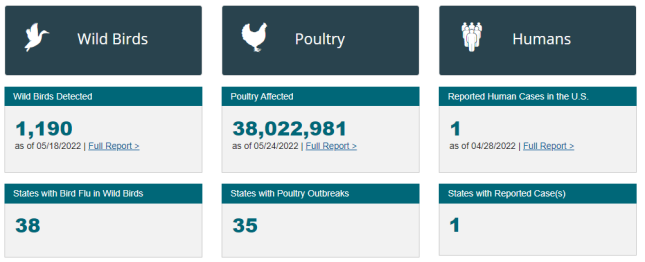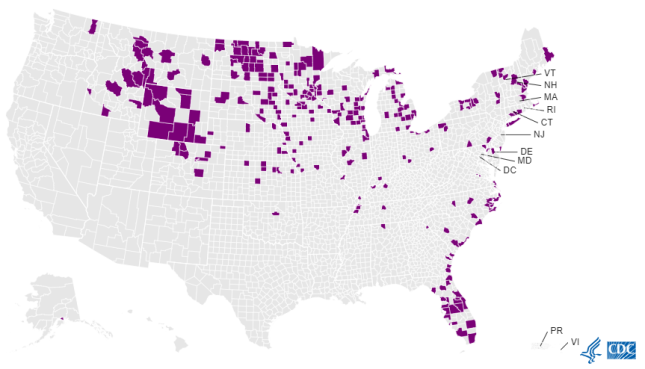
Updated 5/25/2022
Following closely on the heels of 2021’s Pine Siskin and Goldfinch Salmonella outbreak and “Mysterious Bird Disease” is the 2022 Avian Flu scare. Recently, news reports have circulated calling the outbreak “nationwide,” and some people have called for a temporary halt to feeding birds at home to help stop the spread. We at Wild Birds Unlimited are more concerned about the health and safety of our birds than we are about selling bird seed, so we are here to give you the facts without the hype, just as we did with last year’s health concerns.
Let’s start with what avian flu is. Avian flu, like human flu strains, is a highly transmittable disease that is found naturally in the bird world, mostly amongst waterfowl, and is often carried with little or no symptoms. It can spread from one species to another, however, spread is typically limited to within the same species or species that congregate with one another. In some cases raptors or scavengers contract the disease and it can be more severe in these birds than in waterfowl. Avian flu also affects domestic fowl, such as chickens and possibly turkeys, ducks, geese and other farm-raised birds that are in close proximity to one another and may come into contact with infected “wild birds.” My suspicion is transmission to birds of prey and scavengers is most likely caused by eating infected waterfowl or by sharing foods sources in commercial poultry facilities.
For clarification, the term “wild birds” as used in news and various government agency reports is used to refer to ANY birds that are not domesticated or farm-raised. The term refers to the aforementioned waterfowl and raptors, as well as songbirds. As of May 25th, I have heard of one blue jay in Nova Scotia having contracted the disease. While jays are often found at feeders, they will also scavenge food, including carrion, which I suspect is how it contracted the disease. In addition, of the 1190 confirmed wild bird cases in the US, about a half dozen crows (also scavengers), and one American Robin have died from the disease. NONE of these cases have been in Arkansas. 1190 sounds like a lot of birds, but consider these cases are spread over 38 states and 278 counties. That means, on average, there are a mere 4.28 wild birds per affected county, and remember, most of those are NOT feeder birds! By contrast, there have been over 38 MILLION commercial poultry affected. There has been one confirmed case of a human having contracted the virus, but this person was working directly with known affected poultry.

As of this writing, the problem amongst wild birds is no where near epidemic as news stories and blogs may lead you to believe. We saw this same kind of sensationalism last year with the so-called “mysterious bird disease” that caused a panic across the country when in fact the cases of the illness were limited to very specific geographic regions. The same applies here with the avian flu (updates will be forthcoming if trends change).

What should you do?
We all nwant to protect our birds, that’s a given. The first step is to clean feeders and birdbaths regularly with soap and hot water. Second, do not feed your birds more than they can consume in a few days to help prevent decaying food in the feeders. It is also helpful to regularly clean up any mess that may be under your feeders.
If you should see a sick or dead bird, remember that birds, like humans get sick and die naturally, so don’t panic. If you find more than one dead bird in close proximity and/or in a short space of time, then (wearing gloves) take down your feeders and discard any remaining seed in the trash, wash the feeders and use bleach to disinfect them, being sure to rinse extremely well, and then put your feeders away for a period of two weeks to force the feeder-birds to ‘socially distance’ while whatever is affecting them plays out. Clean and disinfect your birdbaths also, and leave them empty for the same two week period. You should dispose any dead birds in the trash, OR, if you are concerned as to the cause of death, you can collect them in a plastic bag and contact the Arkansas Veterinary Lab (info below) in a timely manner to see if they want to test them for pathogens. We have been advised that taking pictures and making notes about a bird's appearance BEFORE bagging it up can be very helpful as time and temperature can diminish many of the physical symptoms used to diagnose a disease. Once a bird has been bagged, keep it in a cold place (fridge or cooler with ice packs) to help preserve it as much as possible. Remember, ALWAYS use good hygiene techniques whenever handling feeders and especially if handling dead birds! Wear gloves that can be disposed of or sanitized, and wash your hands thoroughly after handling. A face mask isn't a bad idea either...if you should happen to have one lying around somewhere (wink wink)!
Please check our website often for updates to this information at www.littlerock.wbu.com.
John Sommer
Wild Birds Unlimited - Little Rock
201.666.4210
* The opinions offered herein are those of the author and do not necessarily reflect the opinions the sources cited or those of Wild Birds Unlimited, Inc. or any of its franchises. The opinions expressed are the result of the author’s own research using the websites listed below and other similar resources sourced on May 25th, 2022.
Resources:
https://www.cdc.gov/flu/avianflu/index.htm
https://www.cdc.gov/flu/avianflu/avian-flu-summary.htm
https://www.cdc.gov/flu/avianflu/data-map-wild-birds.html
https://cwhl.vet.cornell.edu/article/highly-pathogenic-avian-influenza-update-032422
https://www.cdc.gov/flu/avianflu/prevention.htm#Protective-actions-wild-birds

